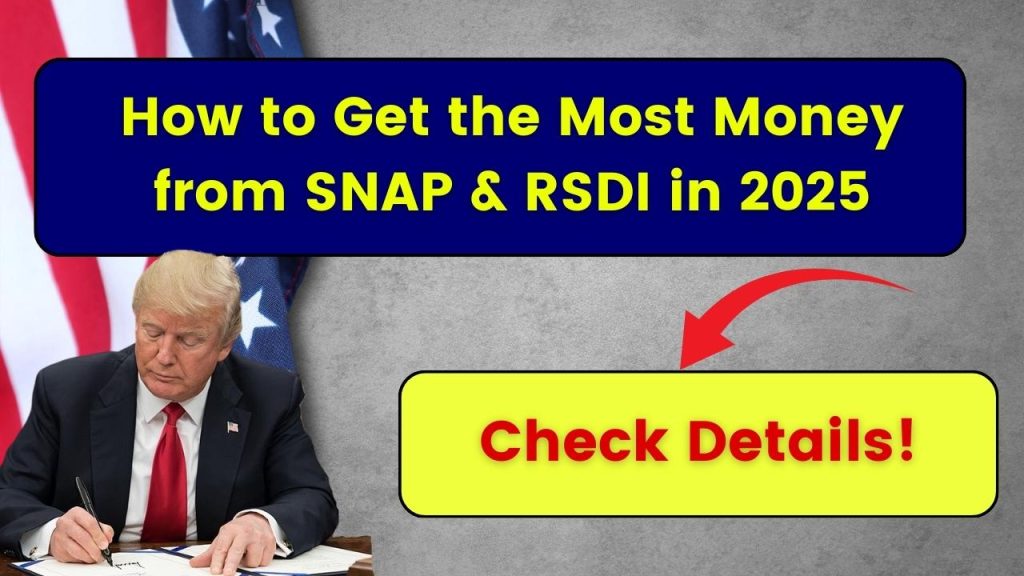
How to Get the Most Money from SNAP & RSDI in 2025: If you’re wondering how to get the most money from SNAP & RSDI in 2025, you’re not alone. With inflation on the rise, the cost of living going up, and ever-changing government programs, more and more Americans are searching for ways to stretch every dollar. Whether you’re new to these programs or have relied on them for years, understanding the updates and new rules for 2025 can make a big difference in your monthly finances. This guide is designed to help you get the maximum amount of support available.
How to Get the Most Money from SNAP & RSDI in 2025
| Topic | Details |
|---|---|
| SNAP Max Allotment (Family of 4) | $975/month in the 48 contiguous states and D.C. (USDA Source) |
| SNAP Benefit Updates | Adjusted for inflation; new shelter deductions and cost-of-living increases |
| RSDI COLA Adjustment | 2.5% increase in 2025 (SSA Source) |
| SSDI SGA Limit | $1,620/month (non-blind), $2,700/month (blind) |
| SNAP Bonus Programs | Double Up Food Bucks and other state-specific incentives |
| Additional Resources | Social Security Administration, USDA SNAP |
Getting the most from SNAP and RSDI in 2025 is all about being informed, staying organized, and taking advantage of available resources. By understanding the updated income limits, COLA adjustments, and eligibility rules, you can make smarter financial decisions for yourself and your family.
Programs like these exist to support you through life’s challenges. Don’t leave money on the table. Use this guide to get every dollar you’re entitled to, and be proactive about managing your benefits.
What Are SNAP and RSDI?
SNAP: Supplemental Nutrition Assistance Program
The Supplemental Nutrition Assistance Program (SNAP) is a federal program that helps individuals and families with low incomes afford food. Previously known as “food stamps,” SNAP delivers monthly benefits through an EBT card. These funds can be used at grocery stores, convenience stores, and even farmers markets that accept EBT.
SNAP is overseen by the U.S. Department of Agriculture but administered by individual states. The benefits are calculated based on your household size, income, and deductible expenses. It’s not just about free groceries – it’s a lifeline for millions of families. In 2025, the program has become more accessible thanks to improvements in digital services and partnerships with community organizations.
Some states also have mobile apps or websites that let you check your balance, upload verification documents, and get local discounts at partnering businesses. This added layer of convenience can help you stay on top of your benefits and plan your monthly budget more effectively.
RSDI: Retirement, Survivors, and Disability Insurance
RSDI is a core part of the Social Security system, encompassing three major benefit categories:
- Retirement benefits paid to workers who have contributed through payroll taxes.
- Survivors benefits available to family members (e.g., children, spouses, or parents) of deceased workers.
- Disability Insurance (SSDI), which supports people who are no longer able to work due to a qualifying medical condition.
These benefits are earned through work credits and can provide a critical financial safety net throughout your life and the lives of your dependents. Many people don’t realize they may qualify for multiple forms of assistance, such as a combination of retirement and survivor benefits, or disability and food aid.
Understanding these distinctions and overlaps is key to making strategic decisions about when and how to apply.
How to Maximize SNAP Benefits in 2025
1. Know the 2025 Income Limits and Allotments
Every year, the USDA adjusts SNAP income eligibility and benefit amounts to reflect inflation and food cost trends. For 2025, the maximum allotment for a household of four in the lower 48 states and Washington D.C. is $975/month. If you’re in Alaska, Hawaii, Guam, or the U.S. Virgin Islands, the amount will be higher.
Income limits are based on your gross income (before taxes) and net income (after deductions). Families that include seniors or people with disabilities have access to additional deductions. For example, a household with an elderly member might qualify for a medical expense deduction, reducing their net income and increasing their monthly SNAP allotment.
Make sure you refer to the latest SNAP eligibility guidelines to understand where you fit.
2. Deduct Every Eligible Expense
When applying or recertifying for SNAP, it’s essential to report all allowable expenses. These deductions help reduce your countable income, potentially qualifying you for higher benefits.
Examples include:
- Housing and utility costs
- Dependent care costs (e.g., babysitting or daycare)
- Medical expenses over $35/month for elderly or disabled members
- Child support payments
Also include transportation to medical appointments and out-of-pocket costs for health insurance premiums if you’re eligible. These add up quickly and can push you into a higher benefit tier.
Keep good records, receipts, and documentation. Every dollar you spend on these necessities can translate into higher food benefits. It may also help you qualify for other local support services.
3. Take Advantage of Bonus Programs
Many communities participate in incentive programs designed to boost the value of your SNAP dollars.
- Double Up Food Bucks: This program matches what you spend on fruits and veggies, up to a daily or weekly limit.
- Healthy Incentives Programs (HIP): Some states provide rebates when you buy certain healthy foods.
Some local food co-ops offer additional discounts to SNAP recipients or allow you to join their member programs for free. These bonuses not only help you eat healthier but stretch your budget significantly over time.
Find local programs through Double Up America or check your state’s SNAP page.
4. Use SNAP Online and for Meal Delivery
More than 40 states now allow SNAP recipients to shop online through major retailers like Amazon, Walmart, and regional grocers. This is especially helpful for those who are homebound or live in food deserts.
Some states also allow meal delivery through services like Meals on Wheels or Mom’s Meals if you’re elderly, disabled, or homebound. This ensures you’re not only getting food but also meals tailored to your dietary or health needs. Some local hospitals and nonprofits even offer meal prep kits for SNAP households.
5. Know When to Recertify
SNAP benefits aren’t permanent. You’ll need to recertify every 6 to 12 months, depending on your state’s rules. Missing the deadline can result in lost benefits, even if you’re still eligible. Set reminders on your calendar or phone. Some states allow you to recertify online or by phone, saving you a trip to the office.
Many states also send text reminders or email alerts when your recertification date is near. Be sure your contact info is up to date so you don’t miss a notice.
How to Maximize RSDI Benefits in 2025
1. Understand the 2025 COLA Increase
The 2.5% Cost-of-Living Adjustment (COLA) means most Social Security checks got a bump-starting January 2025. For example:
- A monthly benefit of $1,200 in 2024 is now about $1,230.
This increase helps offset rising prices for essentials like groceries, rent, and medical care. While modest, it’s a crucial boost, especially for retirees and those on fixed incomes. For more info, visit the SSA COLA page.
COLA increases happen automatically, but if you think your benefit doesn’t reflect the adjustment, contact the SSA right away. Mistakes happen, and it’s important to resolve discrepancies early.
2. Time Your Retirement Smartly
Deciding when to start drawing Social Security retirement benefits has a big impact:
- Start as early as 62, but you’ll get reduced monthly checks.
- Wait until your Full Retirement Age (66-67) for full benefits.
- Delay until age 70 to get the maximum monthly payout – about 8% more per year after FRA.
Consulting with a Social Security representative or using the official SSA retirement calculator can help you make the most informed decision. It’s a long-term strategy that could add tens of thousands of dollars over your lifetime.
3. Track the SGA Limits if You’re on SSDI
For those on Social Security Disability Insurance (SSDI), you must be mindful of the Substantial Gainful Activity (SGA) limits. In 2025:
- $1,620/month for non-blind individuals
- $2,700/month for those legally blind
If you go above these limits, even accidentally, you could risk losing your SSDI. However, trial work periods, expedited reinstatement, and the Ticket to Work program give you flexibility to test employment without losing your safety net.
Consider working with a benefits counselor who can guide you through income thresholds and help you plan a safe return to work, if desired.
4. Understand Survivor Benefits and Their Timing
Survivor benefits provide monthly payments to family members after a wage earner passes away. These are often overlooked but can be vital for:
- Widows/widowers age 60+ (or 50+ with a disability)
- Children under 18 or in high school
- Dependent parents over age 62
Survivors may be eligible for up to 100% of the deceased worker’s benefit amount depending on their relationship and timing. Coordinate with the SSA to ensure you’re claiming at the right time.
Practical Tips for Both Programs
1. Re-Certify On Time
Missing your SNAP or RSDI recertification date can interrupt your benefits. Always:
- Keep your contact info updated
- Respond to mail or notices promptly
- Submit all required documents early
2. Report Life Changes ASAP
Things like getting married, losing a job, having a baby, or moving can affect your benefits. Report changes within 10 days (or your state’s timeline). It can help increase your support or prevent overpayments.
Some life changes might also make you eligible for more benefits or different programs, such as switching from individual to household benefits or gaining access to child-related support.
3. Seek Free Assistance
Many nonprofits offer help:
- Benefits.gov for general program info
- Local SNAP offices for state-specific help
- NDRN for disability rights and support
- Legal Aid for appeals or denials
Libraries and community centers often offer workshops or application clinics as well. These resources can simplify a stressful process and help you avoid common mistakes.
Will You Receive Two SSA Checks in April 2025? What You Need to Know
2025 Social Security Boost Confirmed – Here’s How Much More You’ll Get
These States Will Dip into Your Social Security in 2025: Are You Affected?
FAQs About How to Get the Most Money from SNAP & RSDI in 2025
Q1: Can I get both SNAP and RSDI?
Yes. Many Americans qualify for both programs. RSDI income counts toward SNAP eligibility but doesn’t disqualify you.
Q2: What counts as income for SNAP?
Income includes wages, Social Security, child support, unemployment, pensions, and rental income. Deductions can help lower your countable income.
Q3: Is SSDI the same as SSI?
No. SSDI is based on your work history and payroll contributions. SSI is for individuals with very limited income/resources and doesn’t require work credits.
Q4: Will my SNAP benefits increase if my rent goes up?
Often, yes. Higher rent means a larger shelter deduction, which can lower your net income and increase your benefit.
Q5: Where do I apply for SNAP or RSDI?
- For SNAP, visit your state’s human services department (directory)
- For RSDI, go to the Social Security Administration (ssa.gov)











